Fault-Tolerant Controller Applied to a Wind System Using a Doubly Fed Induction Generator
Abstract
1. Introduction
2. Wind System Controller Scheme
3. Wind System Model
3.1. Oscillation Mechanical System
3.2. Doubly Fed Induction Generator Electrical Model
3.3. Grid-Side Converter System
4. Converter Control System Design
4.1. Generator Electromagnetic Torque Control System
4.2. Grid-Side Converter Controller
5. Real-Time Symmetrical Components
6. Simulation Results
6.1. Performance of the Wind System Controller under a Phase to Ground Fault in the Utility Grid
6.1.1. Performance of a Non Tolerant Fault Controller in a Phase to Ground Fault
6.1.2. Performance of the Fault-Tolerant Controller Proposed in a Phase to Ground Fault
6.2. Phase to Phase Fault
7. Discussion
8. Conclusions
Author Contributions
Funding
Institutional Review Board Statement
Informed Consent Statement
Data Availability Statement
Conflicts of Interest
References
- Mahadanaarachchi, V.P. Fault Analysis and Protection of Doubly Fed Induction Generator-Based Wind Farms; Oklahoma State University: Stillwater, OK, USA, 2009. [Google Scholar]
- Ouyang, J.; Zheng, D.; Xiong, X.; Xiao, C.; Yu, R. Short-circuit current of doubly fed induction generator under partial and asymmetrical voltage drop. Renew. Energy 2016, 88, 1–11. [Google Scholar] [CrossRef]
- Nazir, M.S.; Wang, Y.; Mahdi, A.J.; Sun, X.; Zhang, C.; Abdalla, A.N. Improving the performance of doubly fed induction generator using fault tolerant control—A hierarchical approach. Appl. Sci. 2020, 10, 924. [Google Scholar] [CrossRef]
- Tilli, A.; Conficoni, C.; Hashemi, A. An effective control solution for doubly-fed induction generator under harsh balanced and unbalanced voltage sags. Control Eng. Pract. 2019, 84, 172–182. [Google Scholar] [CrossRef]
- Jabbour, N.; Tsioumas, E.; Mademlis, C.; Solomin, E. A highly effective fault-ride-through strategy for a wind energy conversion system with a doubly fed induction generator. IEEE Trans. Power Electron. 2020, 35, 8154–8164. [Google Scholar] [CrossRef]
- El-Naggar, A.; Erlich, I. Analysis of fault current contribution of Doubly-Fed Induction Generator Wind Turbines during unbalanced grid faults. Renew. Energy 2016, 91, 137–146. [Google Scholar] [CrossRef]
- Hachicha, F.; Krichen, L. Rotor power control in doubly fed induction generator wind turbine under grid faults. Energy 2012, 44, 853–861. [Google Scholar] [CrossRef]
- Cardenas, R.; Peña, R.; Alepuz, S.; Asher, G. Overview of control systems for the operation of DFIGs in wind energy applications. IEEE Trans. Ind. Electron. 2013, 60, 2776–2798. [Google Scholar] [CrossRef]
- Munteanu, I.; Bratcu, A.I.; CeangĂ, E.; Cutululis, N.A. Optimal Control of Wind Energy Systems: Towards a Global Approach; Springer: Berlin/Heidelberg, Germany, 2008; Volume 22. [Google Scholar]
- Abad, G.; Lopez, J.; Rodriguez, M.; Marroyo, L.; Iwanski, G. Doubly Fed Induction Machine: Modeling and Control for Wind Energy Generation; John Wiley & Sons: Hoboken, NJ, USA, 2011. [Google Scholar]
- Burton, T.L.; Jenkins, N.; Bossanyi, E.; Sharpe, D.; Graham, M. Wind Energy Handbook; John Wiley & Sons: Hoboken, NJ, USA, 2021. [Google Scholar]
- Voltolini, H.; Granza, M.H.; Ivanqui, J.; Carlson, R. Modeling and simulation of the Wind Turbine Emulator using induction motor driven by torque control inverter. In Proceedings of the 2012 10th IEEE/IAS International Conference on Industry Applications, Fortaleza, Brazil, 5–7 November 2012; pp. 1–6. [Google Scholar]
- Sahoo, N.; Satpathy, A.; Kishore, N.; Venkatesh, B. Dc motor-based wind turbine emulator using LabVIEW for wind energy conversion system laboratory setup. Int. J. Electr. Eng. Educ. 2013, 50, 111–126. [Google Scholar] [CrossRef]
- Leonhard, W. Control of Electrical Drives; Springer Science & Business Media: Berlin/Heidelberg, Germany, 2001. [Google Scholar]
- Wu, B.; Lang, Y.; Zargari, N.; Kouro, S. Power Conversion and Control of Wind Energy Systems; John Wiley & Sons: Hoboken, NJ, USA, 2011; Volume 76. [Google Scholar]
- Park, R.H. Two-reaction theory of synchronous machines generalized method of analysis-part I. Trans. Am. Inst. Electr. Eng. 1929, 48, 716–727. [Google Scholar] [CrossRef]
- Morfin, O.A.; Ruiz-Cruz, R.; Loukianov, A.G.; Sánchez, E.N.; Castellanos, M.; Valenzuela, F.A. Torque controller of a doubly-fed induction generator impelled by a DC motor for wind system applications. IET Renew. Power Gener. 2014, 8, 484–497. [Google Scholar] [CrossRef]
- Krause, P.C.; Wasynczuk, O.; Sudhoff, S.D.; Pekarek, S. Analysis of Electric Machinery and Drive Systems; Wiley Online Library: Hoboken, NJ, USA, 2002; Volume 2. [Google Scholar]
- Morfín, O.A.; Zavala-Rubio, L.A.; Ornelas-Téllez, F.; Ramírez-Betancour, R. Compensación de potencia reactiva mediante el control robusto de un STATCOM en un sistema de potencia. Ing. Investig. Y Tecnol. 2021, 22, 1–13. [Google Scholar]
- Sen, P.C. Principles of Electric Machines and Power Electronics; John Wiley & Sons: Hoboken, NJ, USA, 2021. [Google Scholar]
- Chalanga, A.; Kamal, S.; Fridman, L.M.; Bandyopadhyay, B.; Moreno, J.A. Implementation of super-twisting control: Super-twisting and higher order sliding-mode observer-based approaches. IEEE Trans. Ind. Electron. 2016, 63, 3677–3685. [Google Scholar] [CrossRef]
- Moreno, J.A.; Osorio, M. Strict Lyapunov functions for the super-twisting algorithm. IEEE Trans. Autom. Control 2012, 57, 1035–1040. [Google Scholar] [CrossRef]
- Boldea, I. Variable Speed Generators; CRC Press: Boca Raton, FL, USA, 2005. [Google Scholar]
- Loukianov, A.G. Robust block decomposition sliding mode control design. Math. Probl. Eng. 2003, 8, 349–365. [Google Scholar] [CrossRef]
- Shtessel, Y.; Edwards, C.; Fridman, L.; Levant, A. Sliding Mode Control and Observation; Springer: Berlin/Heidelberg, Germany, 2014; Volume 10. [Google Scholar]
- Tremblay, E.; Chandra, A.; Lagace, P.; Gagnon, R. Study of grid-side converter control for grid-connected DFIG wind turbines under unbalanced load condition. In Proceedings of the 2006 IEEE International Symposium on Industrial Electronics, Montreal, QC, Canada, 9–13 July 2006; Volume 2, pp. 1619–1624. [Google Scholar]
- Paap, G.C. Symmetrical components in the time domain and their application to power network calculations. IEEE Trans. Power Syst. 2000, 15, 522–528. [Google Scholar] [CrossRef]
- Iravani, M.; Karimi-Ghartemani, M. Online estimation of steady state and instantaneous symmetrical components. IEE Proc.-Gener. Transm. Distrib. 2003, 150, 616–622. [Google Scholar] [CrossRef]
- Ovando, R.I.; Aguayo, J.; Cotorogea, M. Emulation of a low power wind turbine with a DC motor in Matlab/Simulink®. In Proceedings of the 2007 IEEE Power Electronics Specialists Conference, Orlando, FL, USA, 17–21 June 2007; pp. 859–864. [Google Scholar]
- Mahadanaarachchi, V.P.; Ramakumar, R. Simulation of faults in DFIG-based wind farms. In Proceedings of the 2009 IEEE Power & Energy Society General Meeting, Calgary, AB, Canada, 26–30 July 2009; pp. 1–8. [Google Scholar]
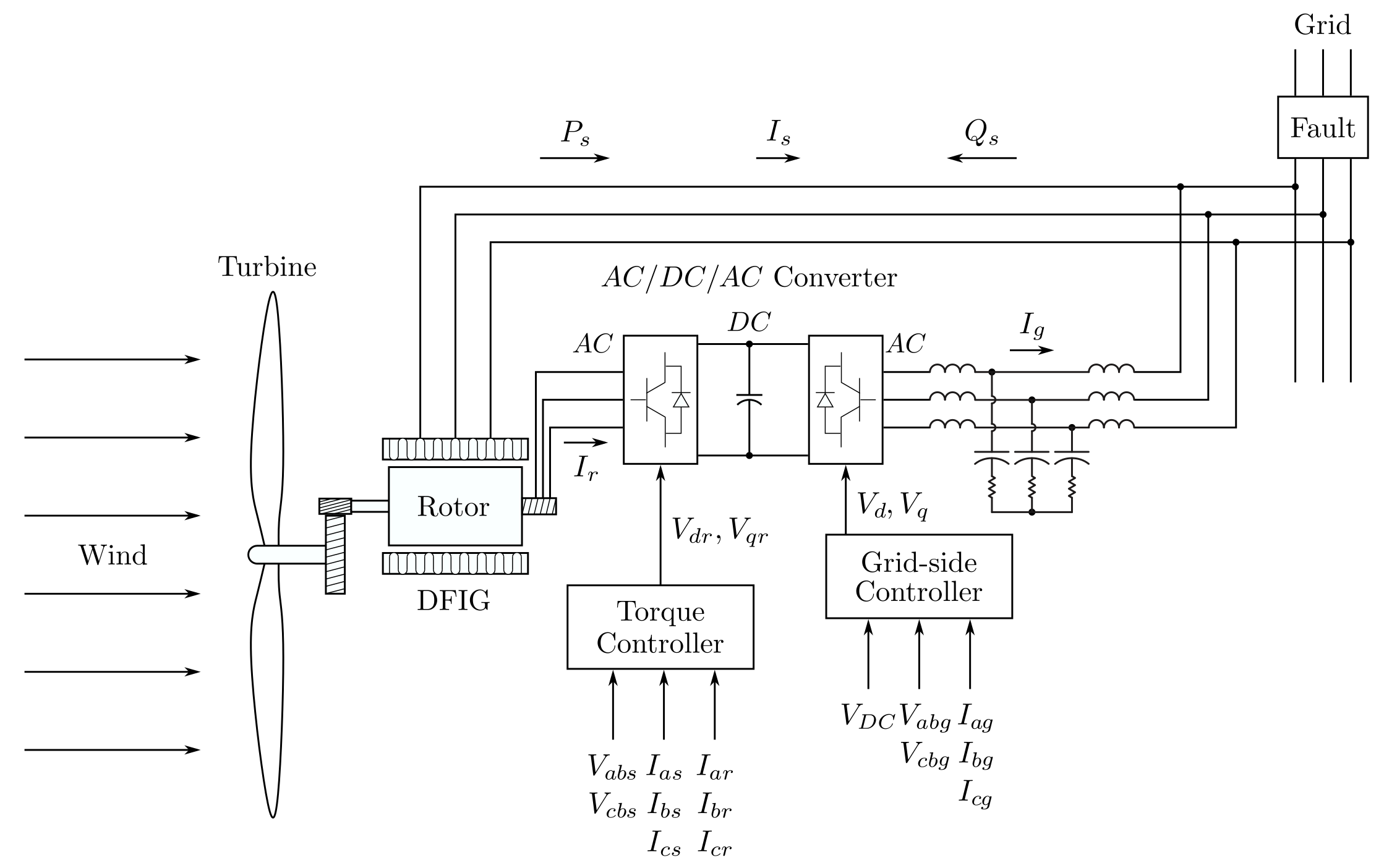
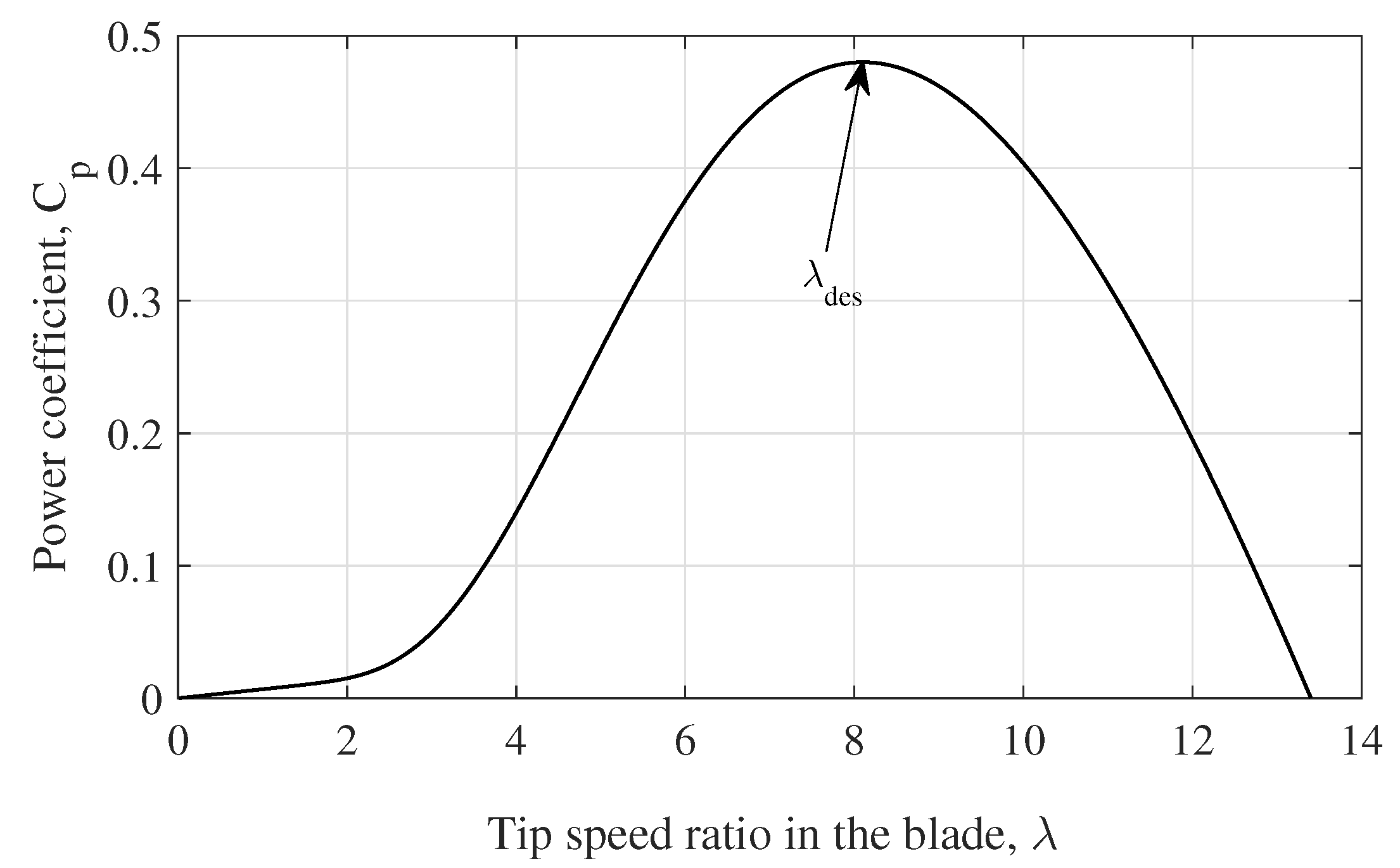
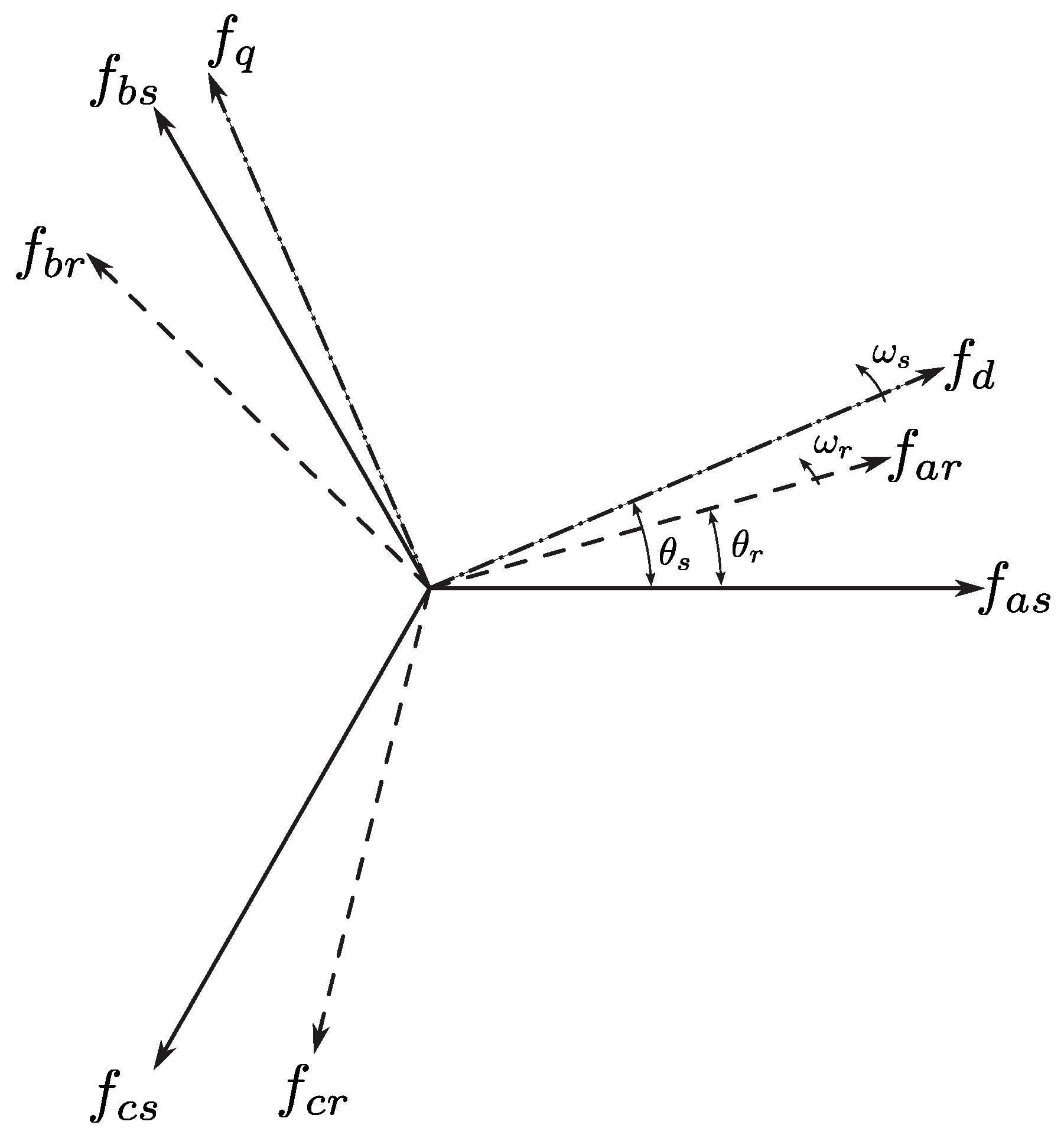
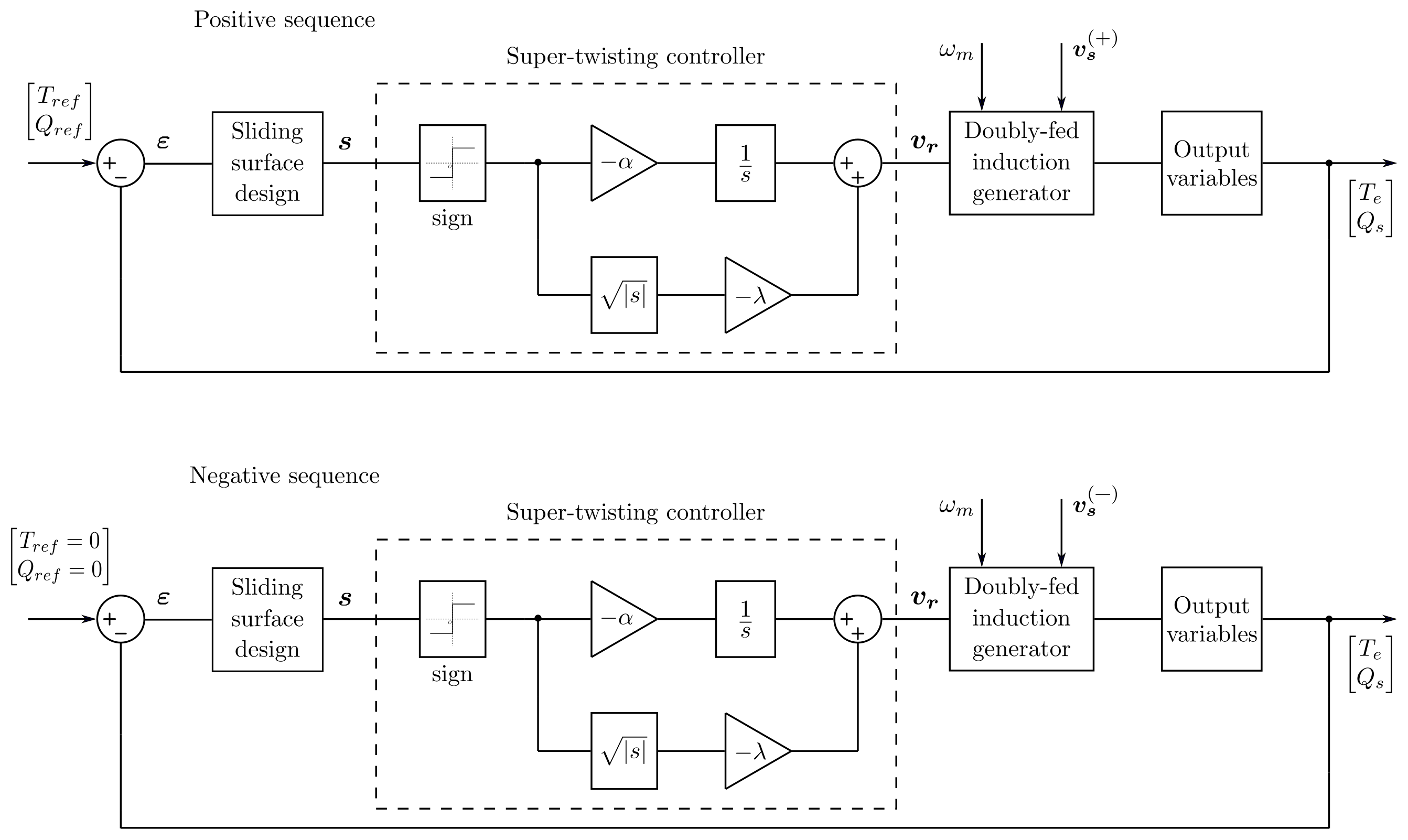

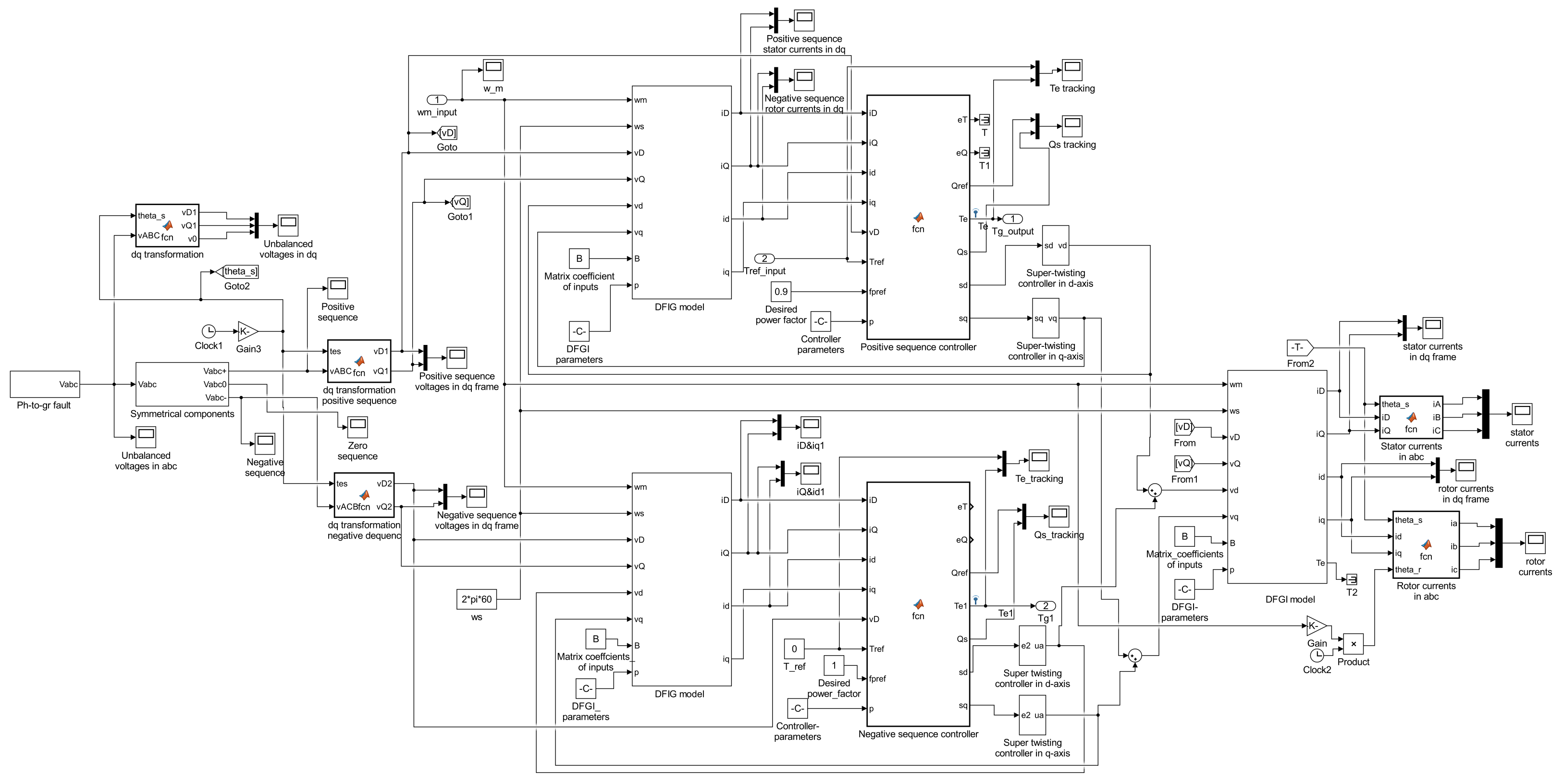
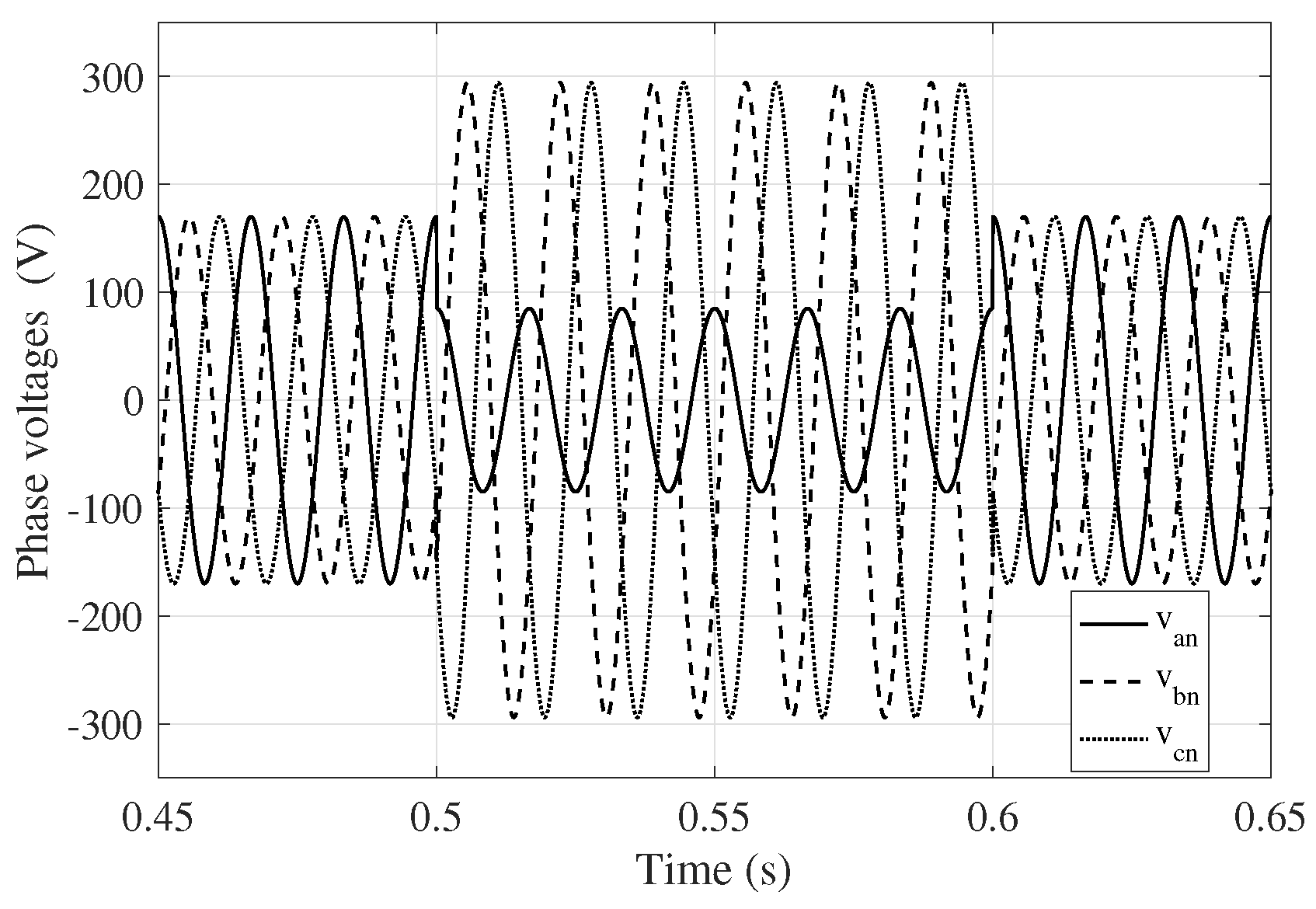
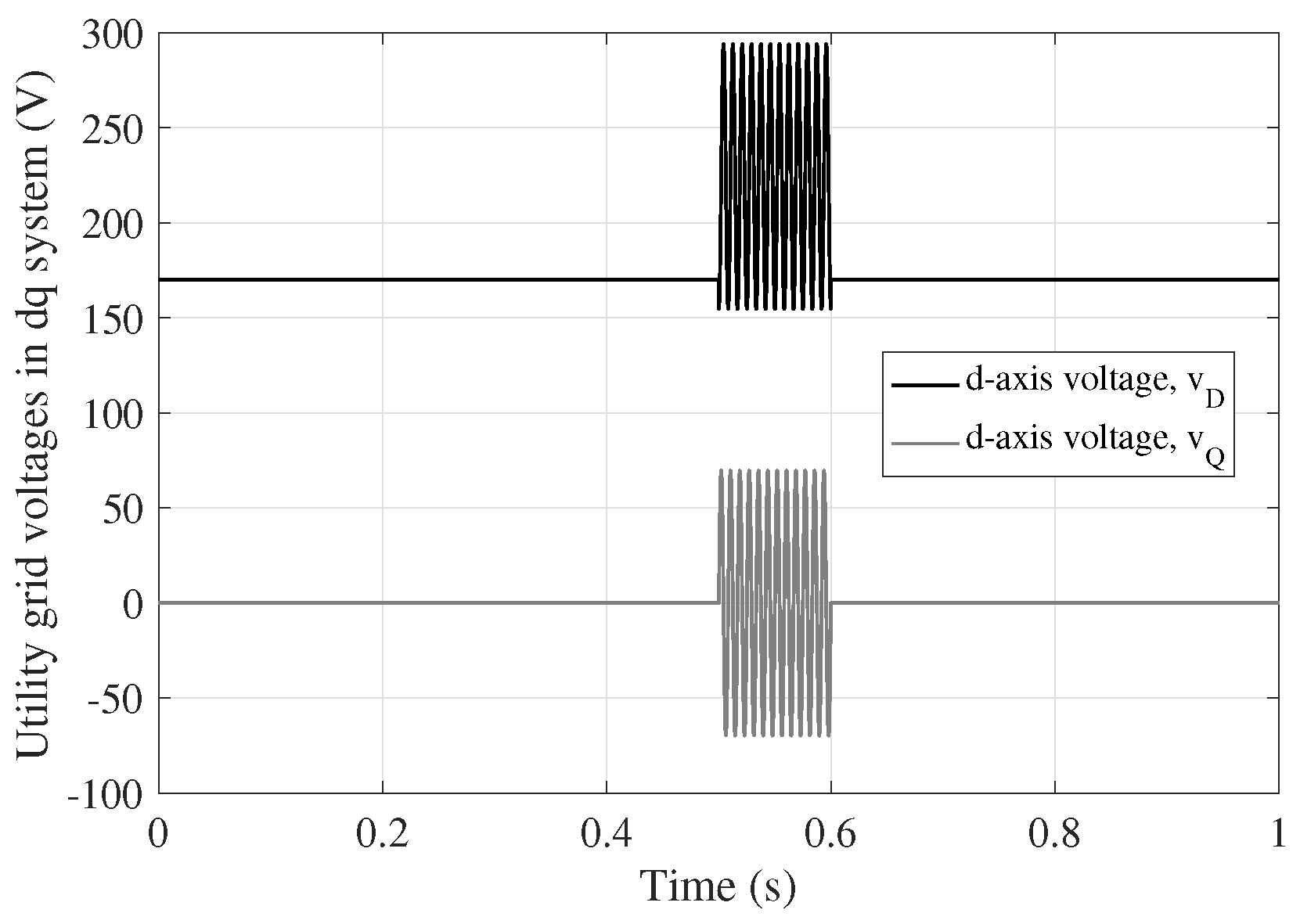
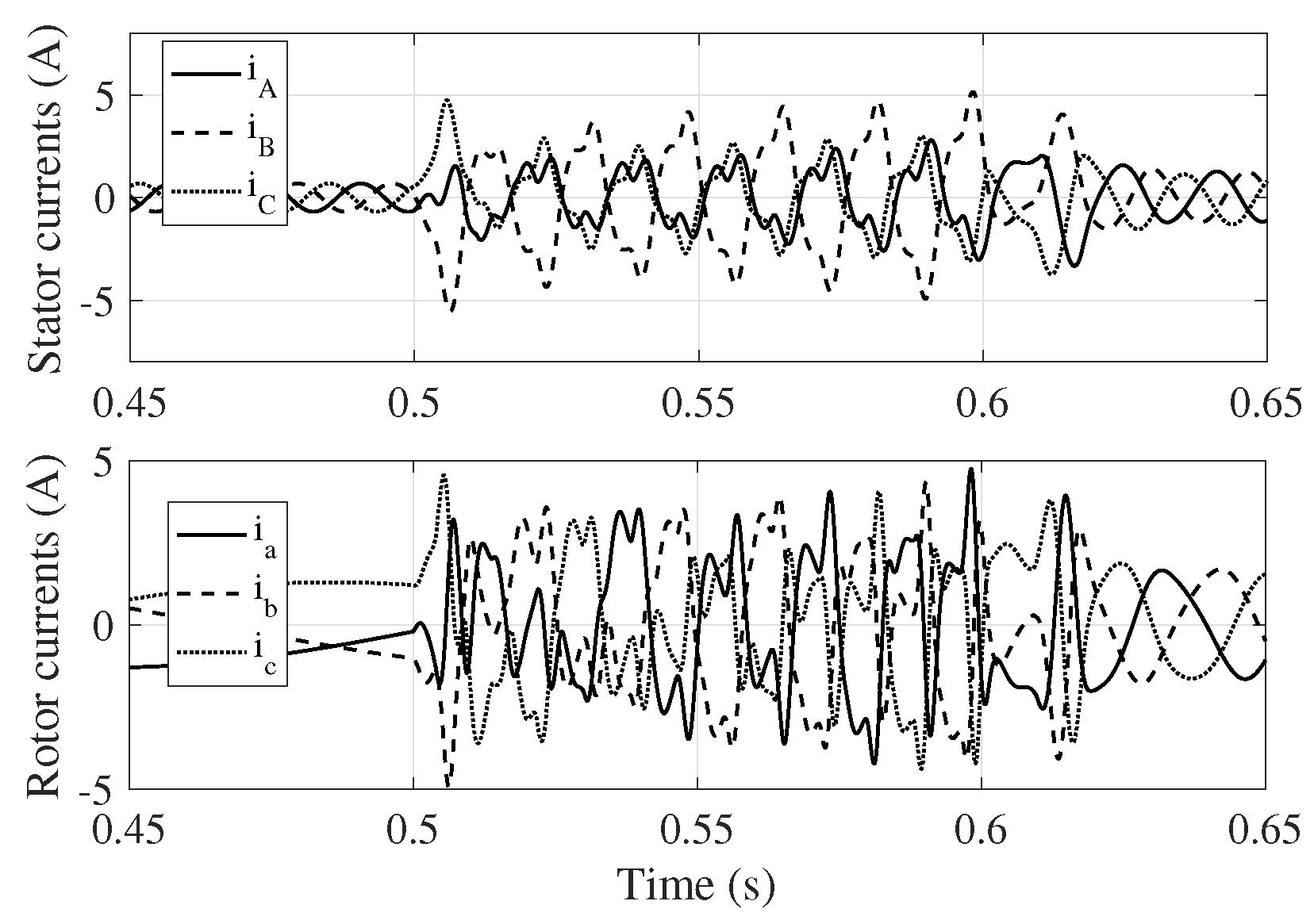
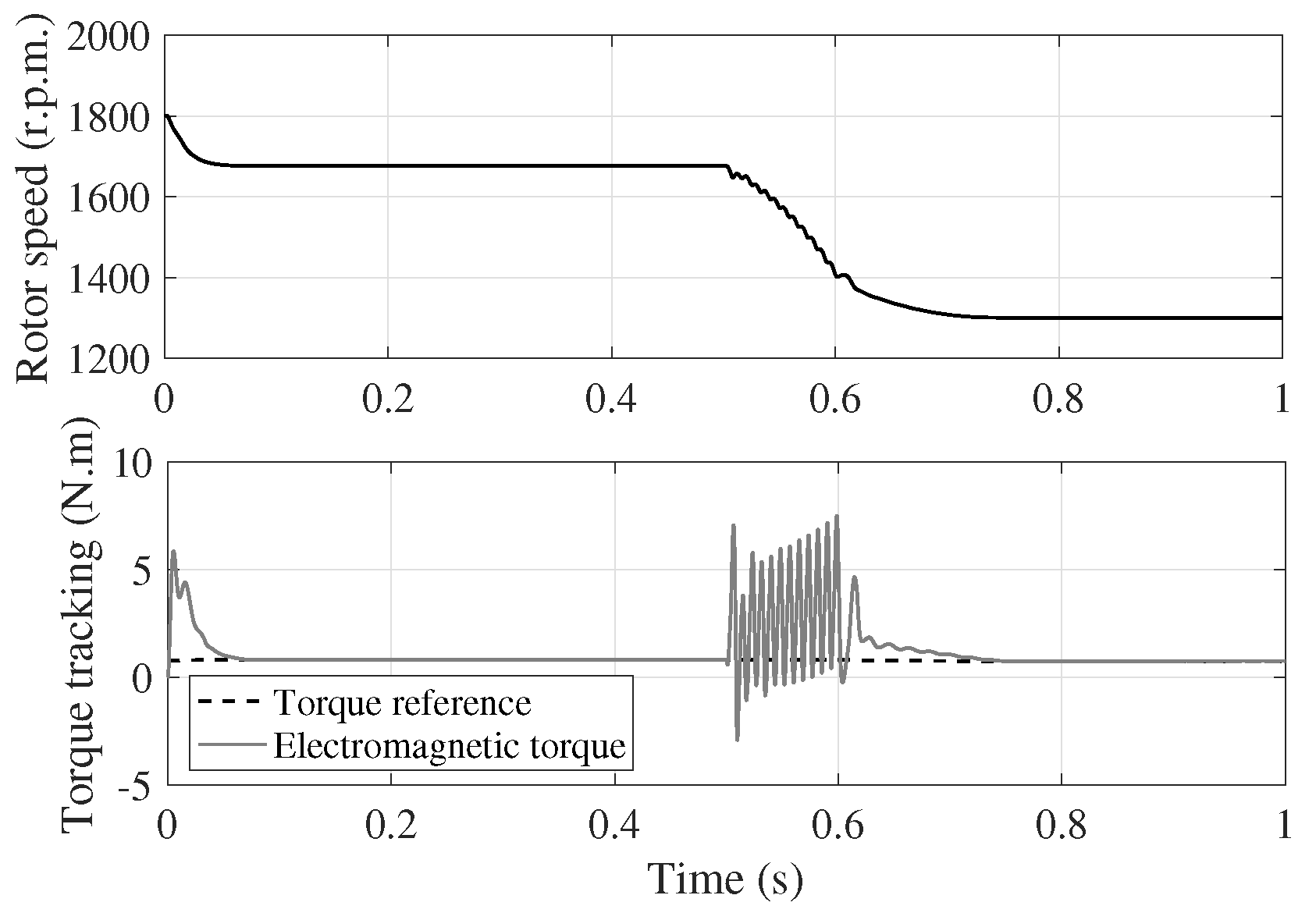
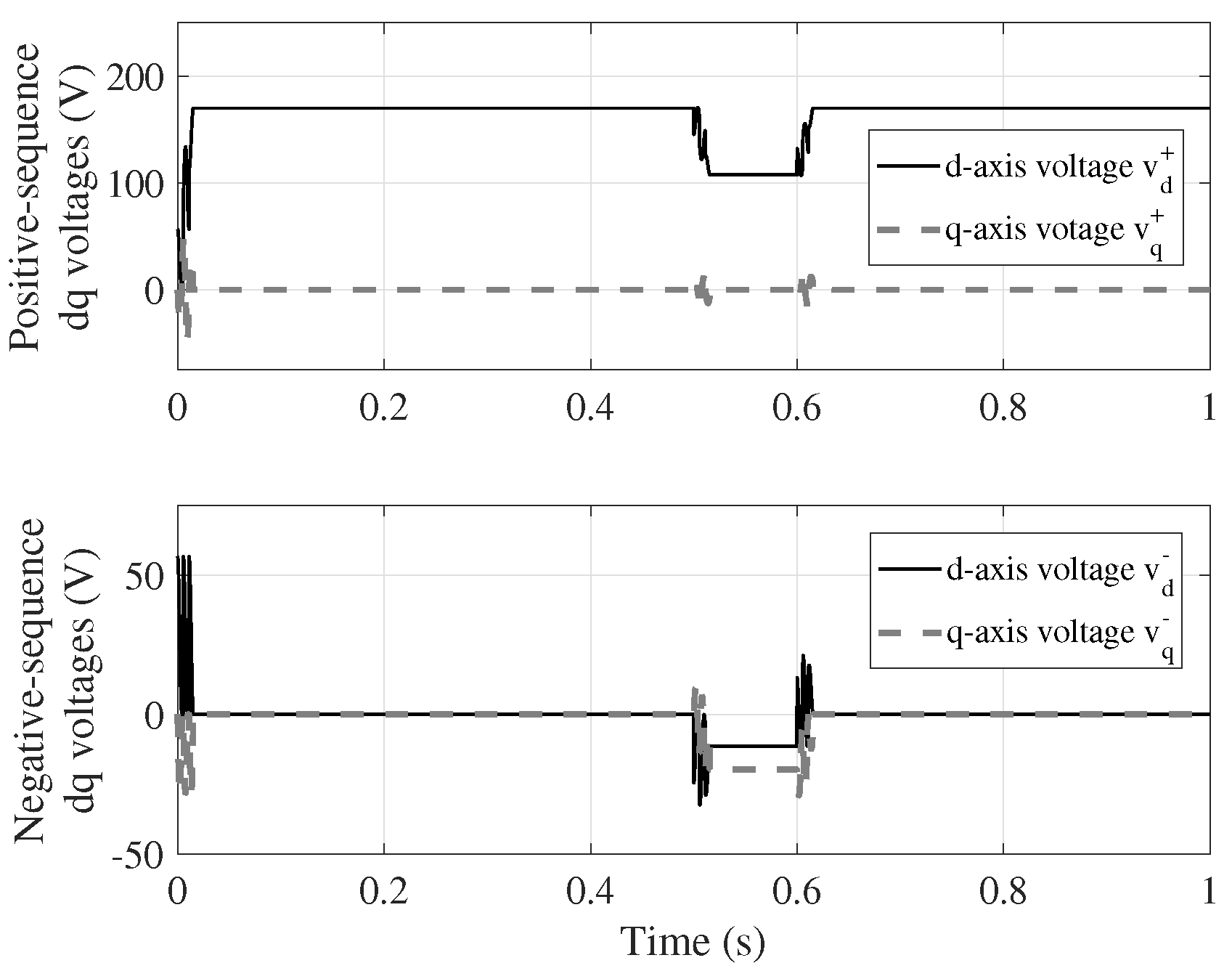
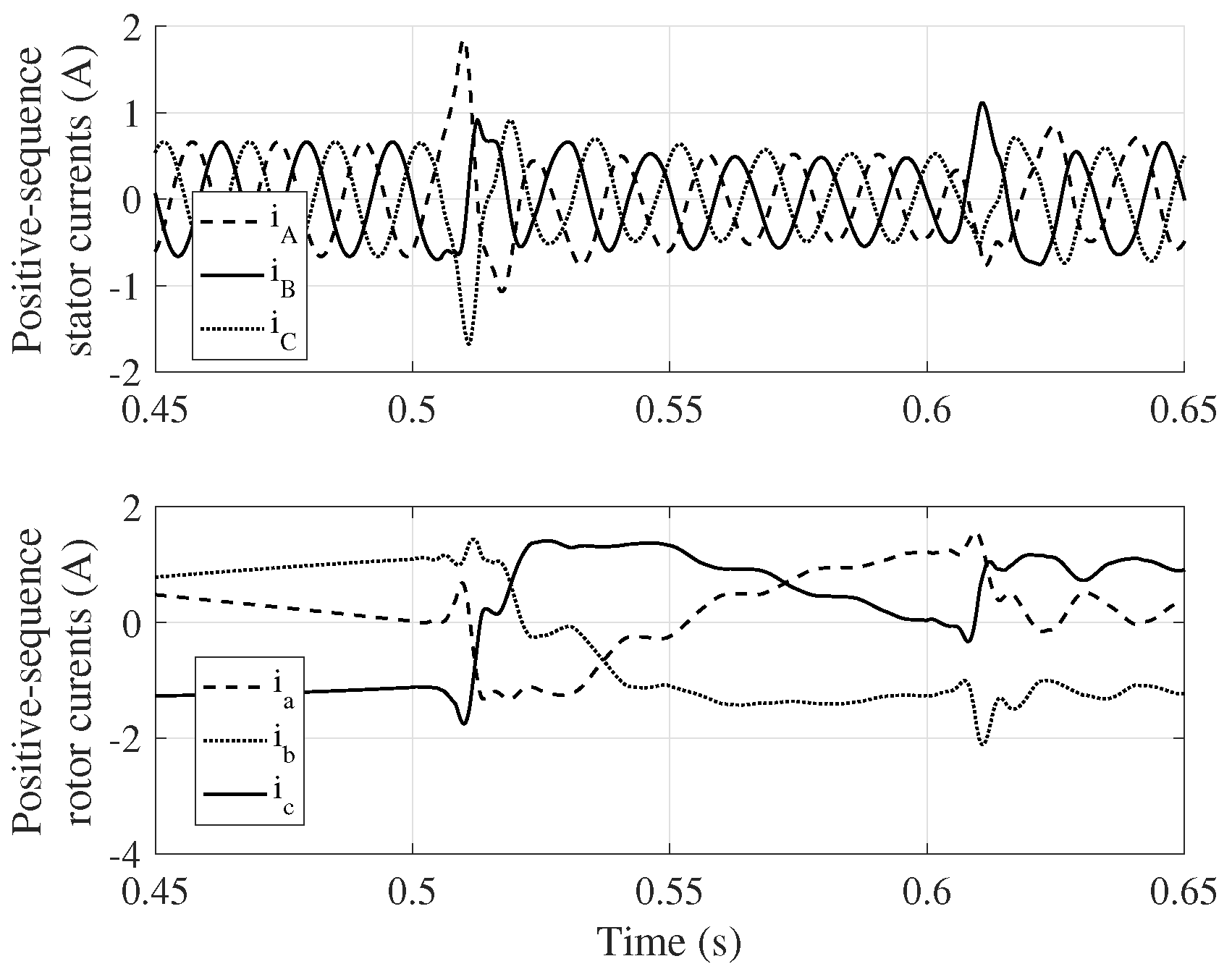
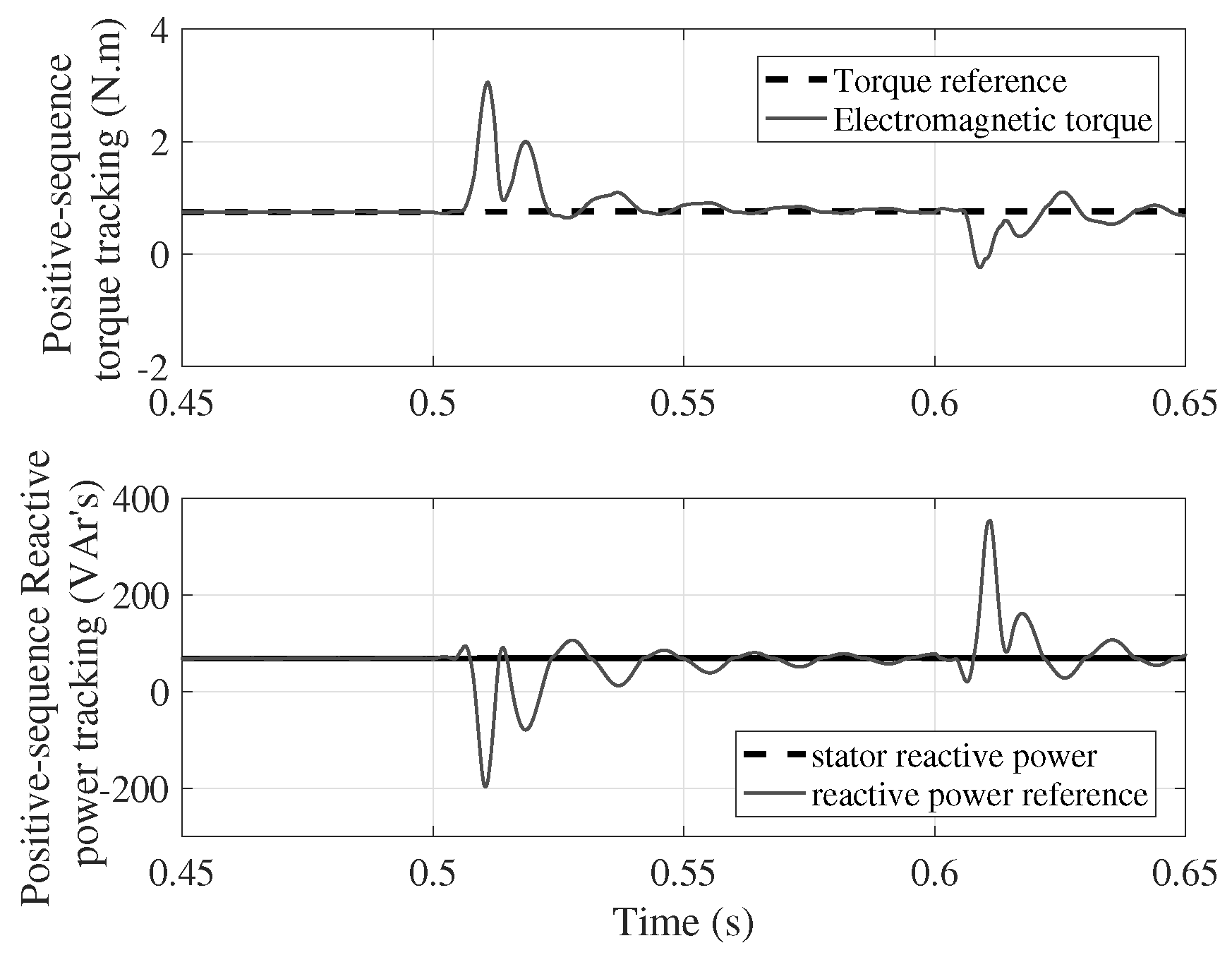
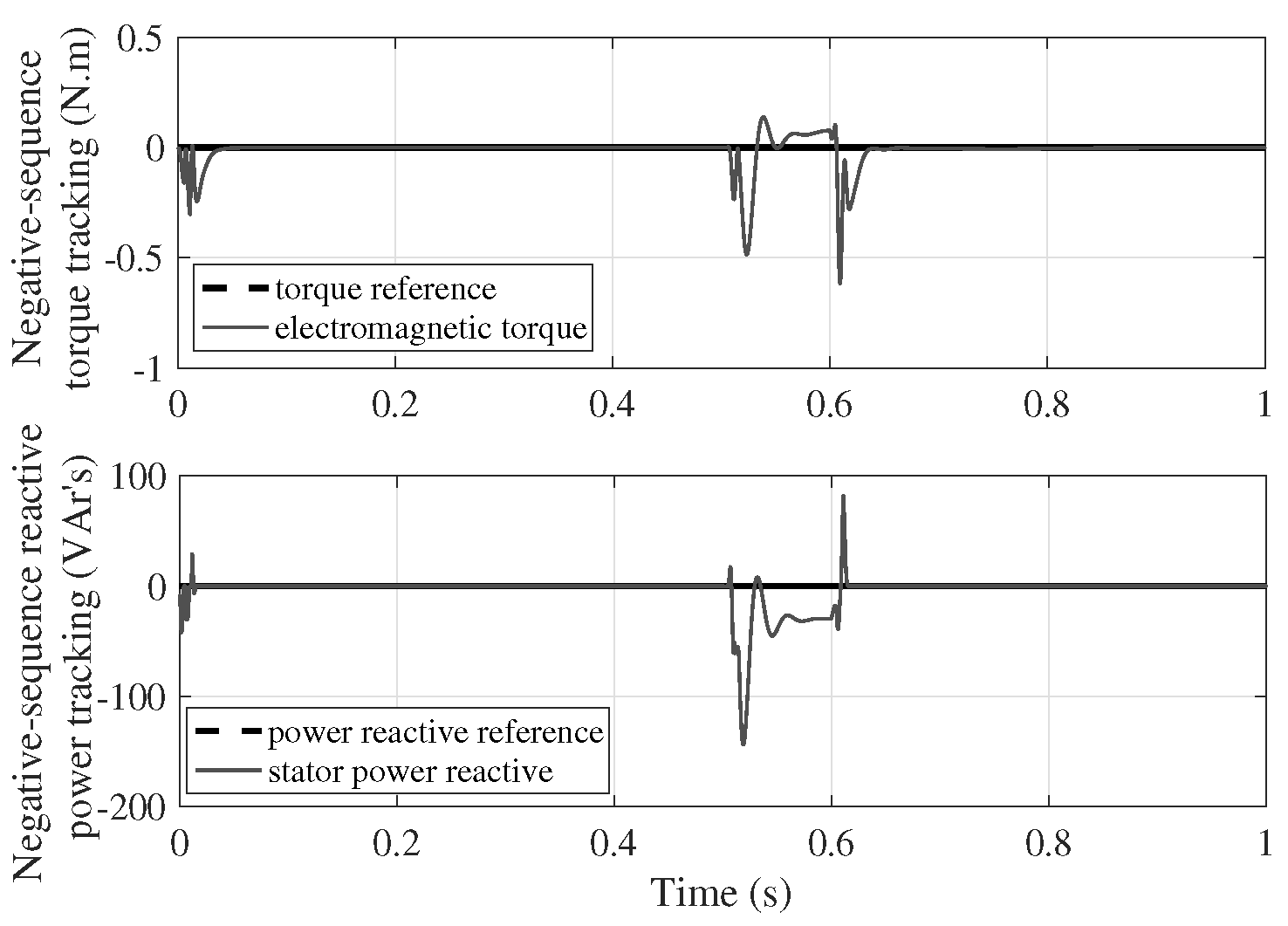

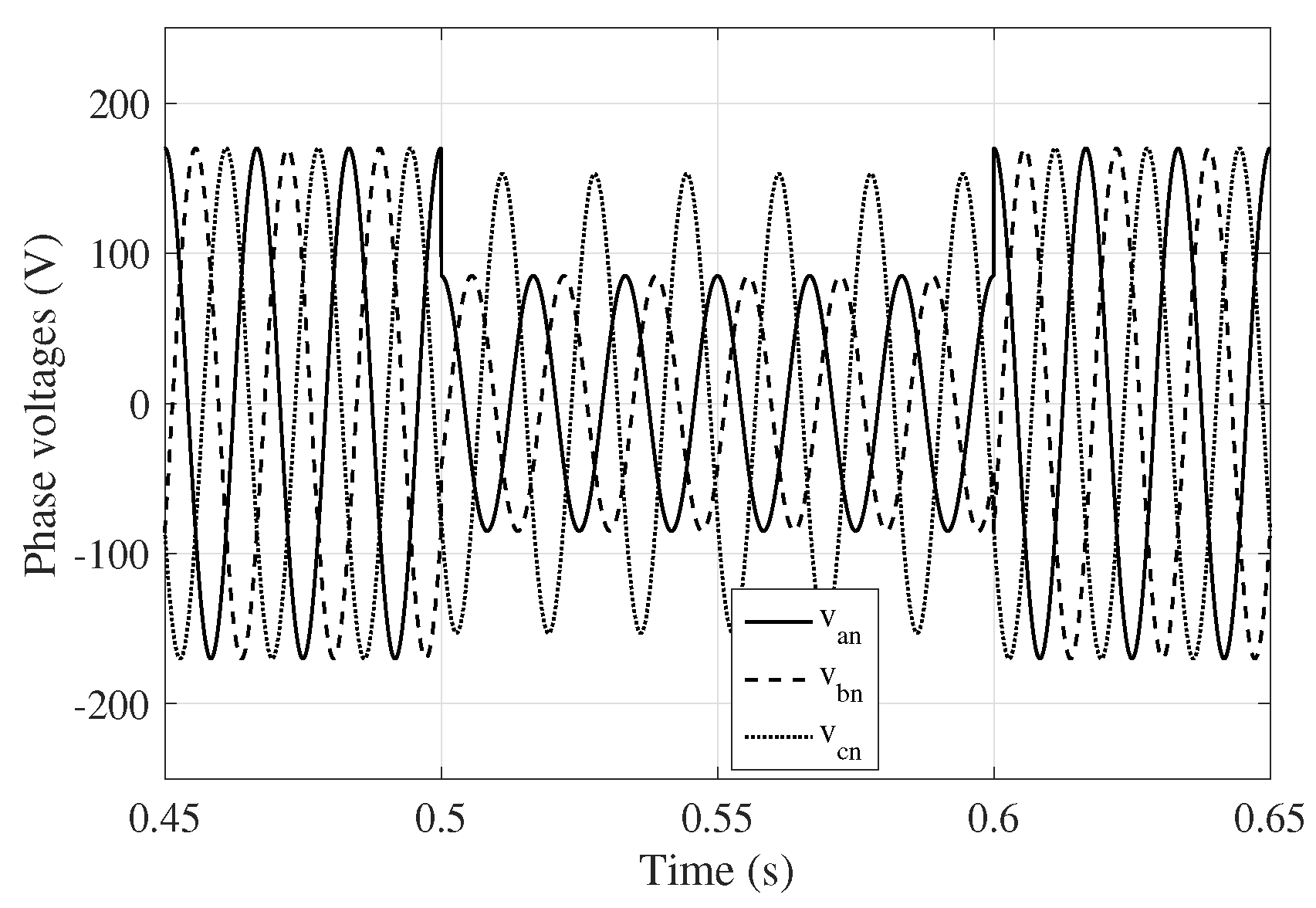
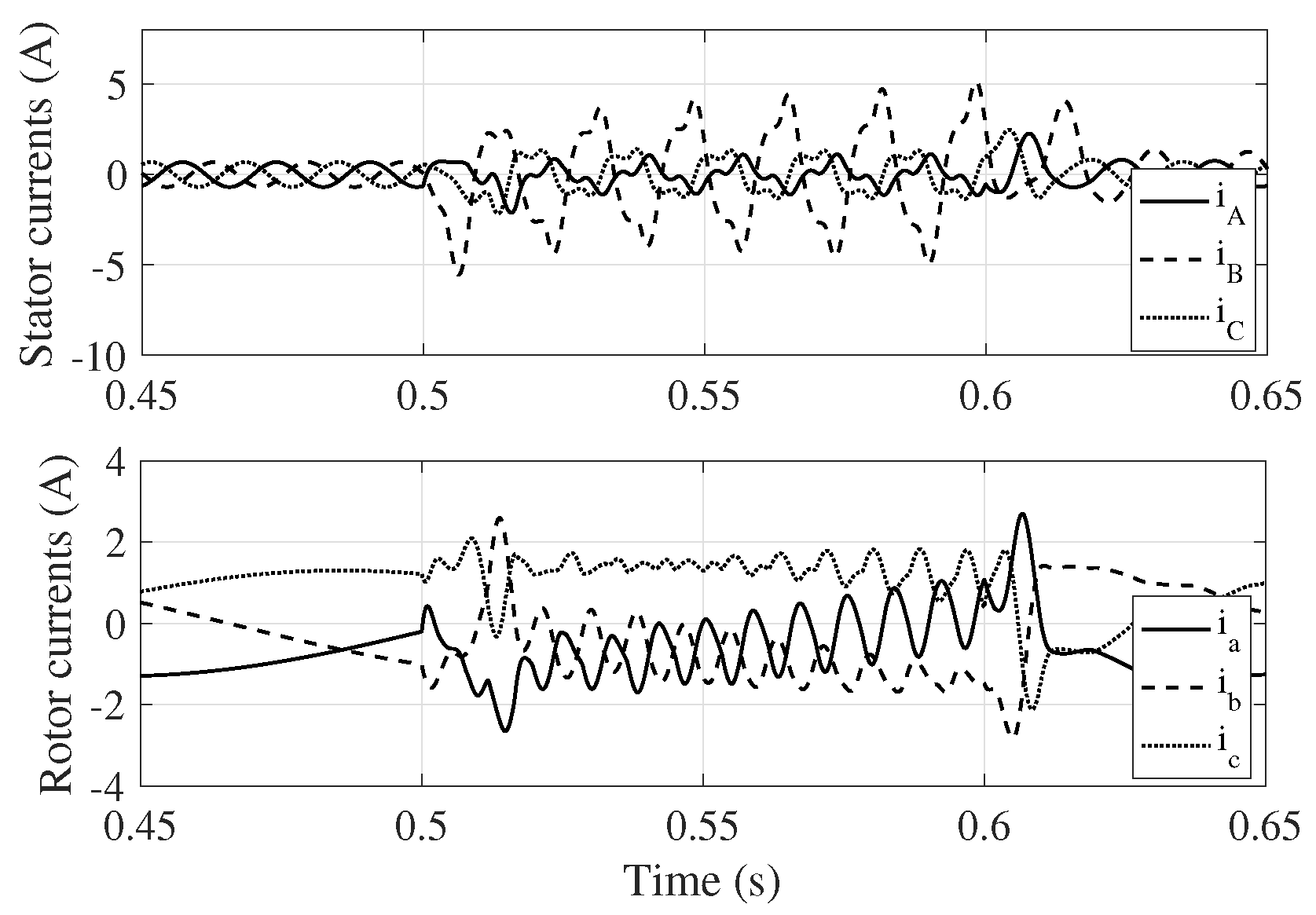
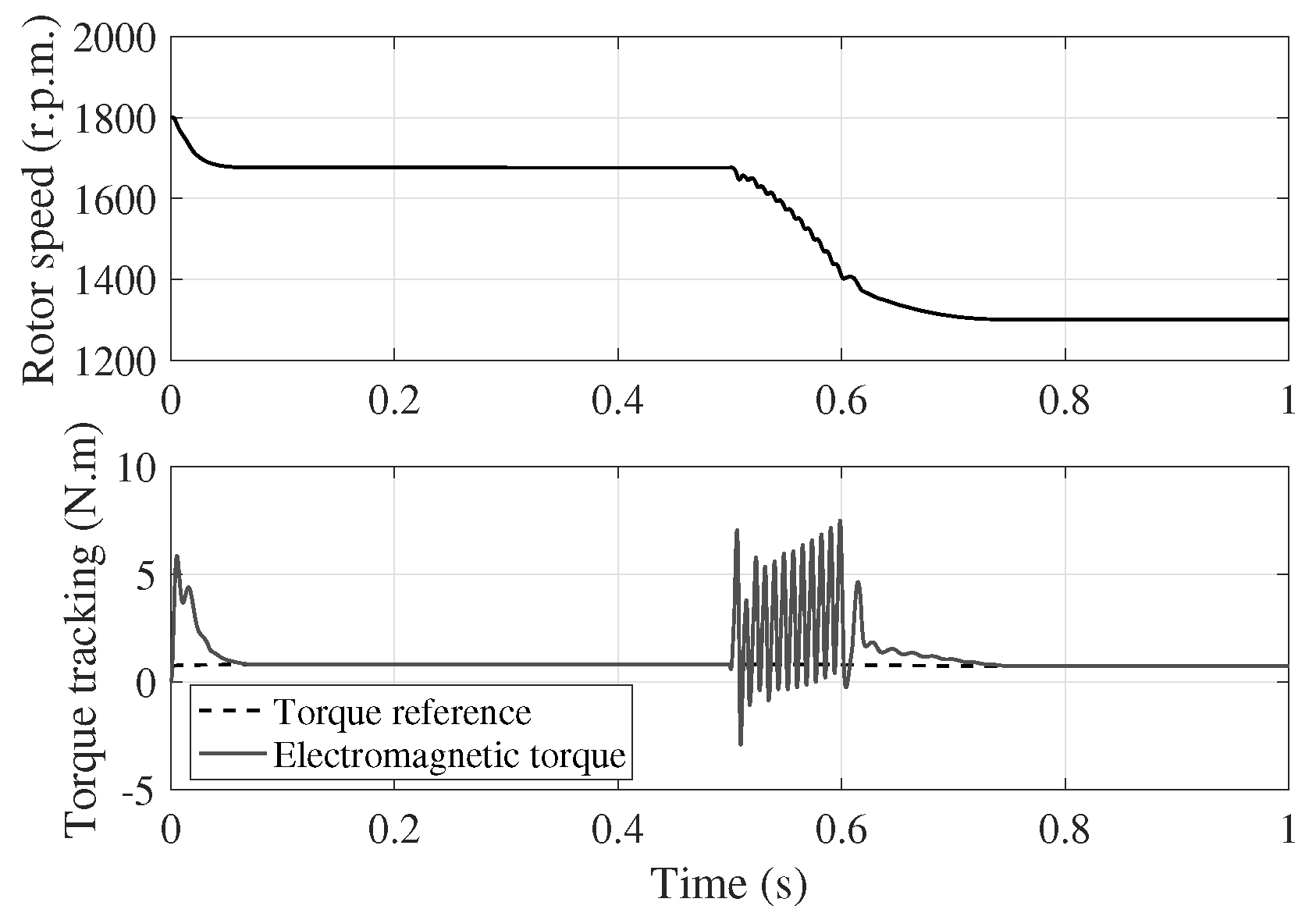
| Parameters | Value |
|---|---|
| Turbine radius, | 1 m |
| Air density | 1.225 kg/m3 |
| Turbine’s inertia momentum, | 0.1 N·m·ss |
| Turbine’s friction coefficient, | 0.1 N·m·ss |
| [0.5176, 116, 0.4] | |
| [5, 21, 0.0068] | |
| Gear-teeth ratio, | 4.2 |
| DFGI Nameplate Data | DFGI Parameters | ||
|---|---|---|---|
| Rated power | 180 W | Poles number, P | 4 |
| Rated velocity | 1750 rpm | Stator resistance, | |
| Line-to-line voltage | 220 V | Rotor resistance, | |
| Magnetization inductance, | 0.352 H | ||
| Stator leakage inductance, | 0.024 H | ||
| Rotor leakage inductance, | 0.028 H | ||
| Inertia moment, | 0.0016 N·m·ss | ||
| Friction coefficient, | 0.00094 N·m·ss | ||
Disclaimer/Publisher’s Note: The statements, opinions and data contained in all publications are solely those of the individual author(s) and contributor(s) and not of MDPI and/or the editor(s). MDPI and/or the editor(s) disclaim responsibility for any injury to people or property resulting from any ideas, methods, instructions or products referred to in the content. |
© 2024 by the authors. Licensee MDPI, Basel, Switzerland. This article is an open access article distributed under the terms and conditions of the Creative Commons Attribution (CC BY) license (https://creativecommons.org/licenses/by/4.0/).
Share and Cite
Morfín, O.; Delgado, D.; Campos, A.; Murillo, M.; Hernández, J.I.; Esquivel, P. Fault-Tolerant Controller Applied to a Wind System Using a Doubly Fed Induction Generator. Wind 2024, 4, 90-110. https://doi.org/10.3390/wind4020005
Morfín O, Delgado D, Campos A, Murillo M, Hernández JI, Esquivel P. Fault-Tolerant Controller Applied to a Wind System Using a Doubly Fed Induction Generator. Wind. 2024; 4(2):90-110. https://doi.org/10.3390/wind4020005
Chicago/Turabian StyleMorfín, Onofre, Diego Delgado, Alan Campos, Miguel Murillo, Jesús I. Hernández, and Pedro Esquivel. 2024. "Fault-Tolerant Controller Applied to a Wind System Using a Doubly Fed Induction Generator" Wind 4, no. 2: 90-110. https://doi.org/10.3390/wind4020005
APA StyleMorfín, O., Delgado, D., Campos, A., Murillo, M., Hernández, J. I., & Esquivel, P. (2024). Fault-Tolerant Controller Applied to a Wind System Using a Doubly Fed Induction Generator. Wind, 4(2), 90-110. https://doi.org/10.3390/wind4020005







